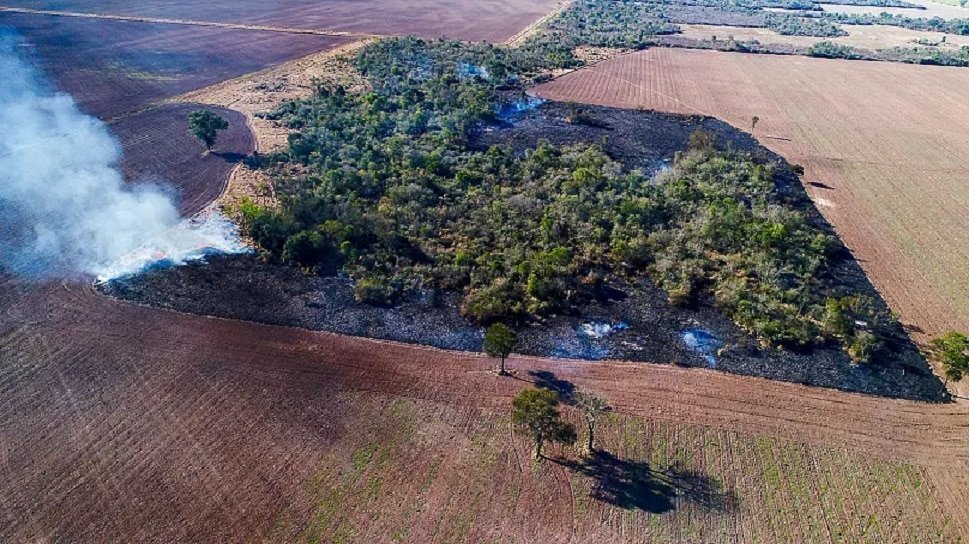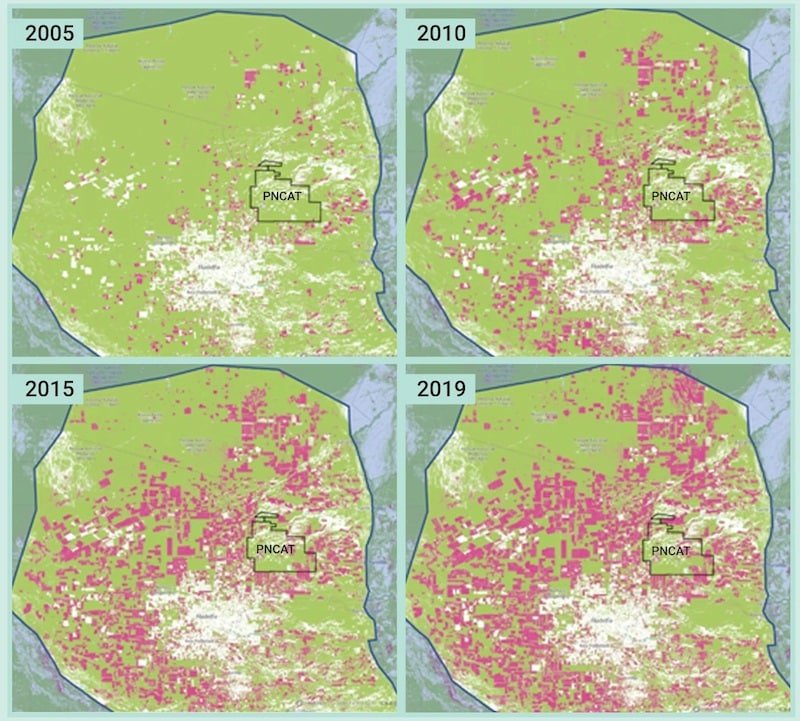Deforestation, forest fires and land grabbing: What's going on in Paraguay?
by Guillermo Achucarro
Deforestation in Paraguay provides the context for understanding many problems related to the country’s current climate crisis. It has caused both countless ecological and environmental imbalances, as well as major social, economic, and political disputes.
Some sectors of society are much more vulnerable than others to the different expressions of the climate crisis, such as native peoples, rural communities and peasant family agriculture, marshland territories, etc. On the other hand, there is also a sector of society with “greater responsibility” than others for the nationwide ecological crisis: large landowners engaged in large-scale agriculture. Based on that understanding, this article discusses several key elements to shed light on structural and political aspects of the climate problem, and to understand the close relations between deforestation, the state, and people with power in Paraguay.

The history of deforestation in Paraguay, in a context of ecological pillage
If the current “climate crisis” has its direct origin in emissions produced by human activities since the industrial revolution, according to scientific consensus, it is essential to analyze humanity’s productive and reproductive processes. The harsh reality of climate change is no longer seen as simply a random phenomenon that may or may not affect certain geographical areas of the planet that are more or less vulnerable to specific weather conditions. Today we have begun to visualize and understand the magnitude of the economic, social, and historic dimensions of so many ecological catastrophes. This is why we now use the term “Crisis”.
In Paraguay, extractive agribusiness activities are among the main emitters of greenhouse gasses (GHG), concentrated in the country’s farming and livestock sector, and more specifically through “land use change” (deforestation) and agriculture[1]. Ownership of this sector in turn is concentrated in the hands of approximately 2% of the population, who own 85% of the country’s land, with a major impact on Paraguay’s Gini index of 0.93, which shows almost “perfect” inequality in the country with the highest concentration of land in the world[2].
Therefore, the environmental and economic impacts of Paraguay’s agro-export economic matrix and its role in the global economic system – as a supplier of raw materials rather than caring for our commons, nature, and people – are directly related to the history that gave rise to such an unequal ownership of the land. Therefore, the problem of deforestation must necessarily be understood in a structural and systemic perspective, and not as an isolated problem, unrelated to Paraguay’s prevailing production model.
With 6 million hectares of land cleared from 2001 to 2019, Paraguay is the country that lost the second largest amount of tree cover in all of South America, after Brazil, according to the Global Forest Watch (GFW)[3] satellite system. Despite having less surface area, our country outstrips Argentina, Peru, and Colombia in terms of areas destroyed[4].

According to the GFW report, 93% of the loss of forest mass in Paraguay was due to activities in the production of raw materials such as beef, soy, and timber. In fact, Paraguay is considered one of the world’s largest exporters of soy and beef. The National Platform for Sustainable Commodities states on its website that soy production covers some 3,380,000 hectares in our country. (La Nación, 2020)
Satellite mapping on deforestation by WWF shows that in the last 10 years, 231,882 hectares have been lost in the departments that make up the “Alto Paraná Atlantic Forest”, which accounts for 45% of all protected areas. The deforested area in fact is larger than the land area of 24 reserves and national parks that make up the regions’ protected areas. In other words, only the Mbaracayú Biosphere Reserve, with its 226,995 hectares, keeps the deforested area smaller than all the total protected areas in this region of the country.
In terms of regions, it was Paraguay’s Gran Chaco (Western Region) that suffered the most in 2019, with 244,324 hectares, or 78% of all areas cleared that year. In the Eastern Region, 69,948 hectares were deforested[5]. In a country where 90% of productive land belongs to families owning agribusiness groups, the political elite is closely intertwined with these interests and has not promoted coherent policies to address deforestation in Paraguay[6].

Notes
According to the IBA3, prepared by Paraguay’s Ministry of the Environment and Sustainable Development (MADES), 50.20% of GHGs come from the “agriculture” sector, 29.11% from the “land use change” sector, 16.28% from the energy sector, 2.59% from the waste sector, and 1.82% from the IPUU sector.
“Estronismo climático: Relación entre la dictadura estronista y la crisis climática en Paraguay”, Acucharro et al.
Global Forest Watch (GFW) is a dynamic online system that monitors and reports on the world’s forested areas. It is a project of the World Resources Institute (WRI) and Google, with the collaboration of 40 international institutions, such as the University of Maryland (UMD), the Center for Global Development (CGD) and the United Nations Environment Programme (UNEP).
La Nación, 2020.
According to the Global Forest Watch platform. 93% of deforestation in 2019 was associated with the production of raw materials, in other words, large-scale deforestation associated mainly with the expansion of commercial agriculture.
La Nación, 2020.
Forest fires as a direct consequence of the economic model
During the months of August, September, and October in both 2019 and 2020, numerous fire outbreaks were reported throughout the country. According to the Hot Spot Report for the Republic of Paraguay, on September 26, 2020, 9,403 hot spots were detected in all departments and in the Capital, most of them in Presidente Hayes, Alto Paraguay, San Pedro, Concepción, and Canindeyú. Once again, in August 2021, a total of 8,699 hot spots were reported nationwide.

That wave of fires affected society’s most vulnerable sectors above all, particularly indigenous peoples and peasants. This section presents several examples to understand the magnitude of the problem.
The Paraguay Local Report (IQLPy, 2020)[7] notes that forest and field fires in the Paraguayan Chaco occur mainly in August and October, and particularly from mid-August to mid-September. It also explains that the origin of these fires is entirely anthropogenic, since fires are customarily set by the agribusiness sector to manage pastures through “controlled burning” of fields, to facilitate the regrowth of pasture foliage, maintaining its nutritional and taste conditions. In this regard, it should be noted that the vast majority of fires do break out in already deforested areas[8].
The Chaco’s livestock area is undergoing a process of “savannization” of its scrublands and forests. With the adoption of practices that leave behind quantitative and qualitative parameters underlying the environmental “balance” of traditional systems, humans’ capacity to control burning and naturally limit fires has been lost. This is particularly the case when the practice of burning spreads into other environments not adapted to fire, such as grasslands and savannas. In the traditional system, composed mainly of native grass species, available fuel biomass usually burns quickly, with a low temperature storage potential, causing ephemeral or almost fleeting ignition processes, with little chance of spreading to higher density vegetation types (IQLPy-2020).
The imprudence of those using “controlled burning” has effectively spread the number of fires throughout Paraguay, and not only in the Chaco, although it is in the Chaco that they have reached enormous proportions.
One example of communities completely vulnerable to such large-scale forest fire problems is the Ayoreo Totobiegosode people, historically rooted in the “Paraguayan Chaco”. In 2019, severe fires in their region forced at least one isolated Ayoreo group to migrate to another part of the Chaco because they were unable to grow or find food there, as a result of the environmental damage. That forced migration drastically increased the likelihood of unwanted encounters with non-indigenous groups[9].
According to the Global Forest Watch (GFW) platform, during the last week of September 2020, a total of 276 fire outbreaks were identified within the Ayoreo Totobiegosode Natural and Cultural Heritage (PNCAT), the Ayoreo people’s historical, ancestral territory. Of those 276 outbreaks, 91 came from the “Yaguareté Pora” ranch[10], located inside the PNCAT protected reserve. A comparison of satellite images by the organization “Earthsight” from September 23 to 28, 2020 showed a total of 12.7 hectares “recently burned”[11].
In October, Earthsight observed approximately 200 fire outbreaks within the Ayoreo ancestral territory. About 150 of them were within the “Caucasian SA” ranch, which belongs to a Brazilian company with a history of legal and land disputes with the Ayoreo people. Those hot spots on Caucasian SA’s land are in areas where illegal deforestation had previously been denounced.
Notes
Mentioned in GTI PIACI (2020).
his clarification is intended to establish a difference between practices related to extensive agriculture and historical peasant practices. As mentioned in the introduction to this article, deforestation in Paraguay is directly related to agribusiness activity. Therefore, the activity of “controlled burns” of fields at the national level is linked to this sector.
Reviewed on November 21, 2020.
This Brazilian cattle company acquired 78,000 hectares of Ayoreo ancestral territory in 2002 through political contacts.
Earthsight, 2020.
The role of the State

The Paraguayan state has consistently promoted rampant deforestation in the Chaco, as it generates and maintains optimal conditions for the expansion of cattle ranching and agribusiness.
Oxfam’s “Yvy Jára (Land Owner)” report describes the generous offer the government makes to cattle ranchers, who are often foreigners: “low prices to buy land, low taxes (with the region’s lowest income tax and VAT), no export tariffs, no limits on land tenure, tax incentives for foreign investment (with exemption from income tax during the first years of investment), international treaties to protect investments or virtually no restrictions on purchases by foreigners. … In addition to all this, there are almost no state controls to enforce environmental and labor regulations”[12].
The non-enforcement of environmental laws is significant because the country’s own Forestry Law (422/73) requires landowners in the Chaco to set aside 25% of their land as nature reserves and another 15% as forested swaths between deforested areas. Yet data from the National Forestry Institute (INFONA) show that 24% of deforestation in the Paraguayan Chaco from 2017 to 2018 had no mandatory environmental licenses for land use change[13].
The current administration is still driving accelerated development in the Chaco[14] and President Abdo Benítez has proven to be a strong defender of livestock and agribusiness interests, dismissing as bums (“haraganes”) anyone advocating tax reforms that might affect this sector[15].
Notes
Reviewed on November 15, 2020.
Reviewed on November 19, 2020.
Guillermo Achucarro graduated as an Environmental Engineer from the National University of Asunción and has a Master’s degree in hydrology from the University of Montpellier-France. He is a researcher on climate policies and energy transition at BASE-Is, a university professor and a social activist.
